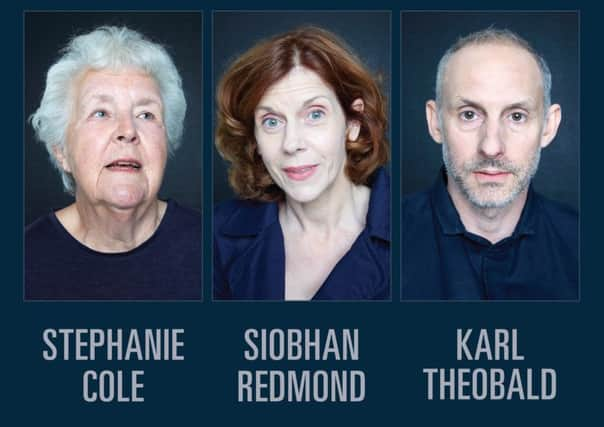REVIEW: Talking Heads (Theatre Royal, Brighton, until Saturday, August 15)


Transferring these claustrophobic televisual treats from a box in the living room to the stage was originally tried back in 1992, when Bennett himself and Patricia Routledge repeated two of their monologues from the first series on the West End stage. Now, three fine actors are performing three of the best remembered stories during a national tour.
The question is not so much whether we can expunge memories of the original, highly memorable, and near-hallowed performances from our minds (surprisingly, this is quite easy thanks to the quality of the actors), but if they really do work as pieces of theatre at all.
Advertisement
Hide AdAdvertisement
Hide AdThese poignant monologues are not, after all, soliloquies or asides delivered with a nod and a wink to their audience, but rather close up, intimate and personal stories told with humour but underscored by themes of sadness, loneliness, despair and a sense of loss.
Director Sarah Esdaile tries to capture the spirit of Bennett in the three pieces and it is perhaps this that is the least successful part of the evening. Instead of allowing the monologues to flow, which is vital, each contains stodgy scene changes, involving the actors fiddling about with props or quite lengthy bringing down of curtain.
The surreal set by Francis O’Connor is particularly nasty: the same basic design for all three pieces, with simple additions and changes of furniture, makes it seem the characters are speaking from an asylum, evoking memories of the 1970s Amicus horror film anthologies. One almost expects Peter Cushing to appear with a malevolent grin after each and draw the curtain across the stage with a sinister chuckle.
But in each case the acting lifts the drab and mundane to a point where the audience cares about the melancholic and identifiable characters. Even those who come already knowing the outcomes could be excused for hoping for something different.
Advertisement
Hide AdAdvertisement
Hide AdIn Lady of Letters Siobhan Redmond is busybody Miss Ruddock, whose letters to all and sundry (MPs and The Queen among them) pretend to address all manner of social ills yet disguise the loner’s search for a relationship or freedom from her lot. Siobhan Redmond conveys the prim sense of justice and self-righteousness that leads both to Miss Ruddock’s downfall and ultimate liberation.
In A Chip in the Sugar Karl Theobald’s mild-mannered Graham finds life spiralling out of control when his elderly mother takes up with an old flame. You can’t help but feel that as his jealousy grows and the truth is uncovered about his mam’s suitor this is the one character who will never be released from his personal prison. Theobald makes the role his own, especially as he tells of the various visitors to the house and explores the background to his instability.
Stephanie Cole plays 75-year-old Doris in A Cream Cracker Under the Settee, a fiercely independent pensioner whose dissatisfaction with her home help snowballs to disaster. Yet Stephanie Cole allows Doris tangible self-awareness which gives her character strength and more than a spark of dignity.
The joy of this production is that it brings three monologues together in which the characters face a personal fight to stay out of what they would regard as fates worse than death (prison, psychiatric care, and a residential home – perhaps the asylum set is significant after all). The original TV series or Bennett’s script are better ways of exploring the characters in depth, but in the end it’s hard to dislike these stories of their time, with such colourful characters portrayed in such a lively way.